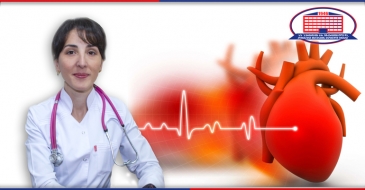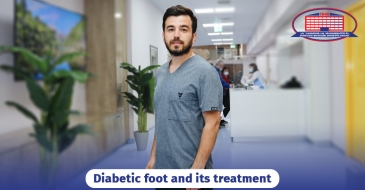
Anemia is a frequent pathology.
During anemia, i.e. anaemia the amount of the red blood cells (erythrocytes) decreases and/or the concentration of the hemoglobin deteriorates in the body.
Hemoglobin is the iron-containing metalloprotein with the help of which erythrocytes carry oxygen in the body. Iron-deficiency anemia (RDA) is caused by the reduction of the iron in the body, as a result of which hemoglobin synthesis is disturbed, its’ content in each erythrocyte is reduced and, subsequently, supplying the oxygen to the organs and tissues is disturbed. The iron deficit is the most frequent reason for anemia. It develops when the balance between the received and spent iron of the body deteriorates.
National Center of Surgery’s hematologist, doctor of medicine Nino Chkhaidze discusses iron-deficiency anemia.
– Ms. Chkhaidze, what causes iron-deficiency anemia?
– The causes of iron-deficiency anemia are:
- Chronic bleeding that might be caused by gastrointestinal tract diseases (ulcer, piles), gynecologic and oncologic pathologies, the intake of some medical substances (for example, salicylates)
- Insufficient amount of iron received through nutrition;
- Increased spending of the iron during an adolescent growth spurt, pregnancy and lactation, excessive, intense sports and physical activities;
- When a person has an insufficient amount of iron from birth;
- When a woman doesn't absorb a sufficient amount of iron during the lactation period;
- Iron absorption failure, i.e. absorption disorder that might develop after the operation on the stomach, during intestine diseases (for example, Crohn's disease, diverticulosis and etc.);
- Iron transportation disorder (the deficit of iron-transporting protein, transferrin deficit – hypo and atransferrinemia);
- Combination of factors mentioned above.
–How to recognize the symptoms ofiron-deficiency anemia?
– Iron-deficiency anemia is characterized by the general anemic symptomatic that is the result of the lack of oxygen in the body caused by erythrocyte and hemoglobin reduction, symptoms are the following:
- General weakness;
- Work ability deterioration;
- Dizziness;
- Heart palpitation;
- Buzzing in the ear;
- Sleepiness;
- Shortness of breath.
The intensity of the symptoms depends on the degree of anemia, i.e. the depth and development speed. Often iron-deficiency anemia develops slowly and that's why the body manages to adapt to a lack of oxygen to a certain extent and as a result, anemic symptoms are less expressed. With deepening anemia, the degree of symptom expression increases.
Besides anemic symptomatic, iron-deficiency anemia is characterized by the combination of symptoms directly caused by iron tissue deficiency. What we, doctors call sideropenic syndrome.
For sideropenic syndrome, the special characterizing symptom is a perversion of the taste, so-called Pica-Chlorotica - the desire to eat soil, chalk, raw minced meat, raw dough and etc. (pathophagy), also, an abnormal inclination to particular smells: acetone, gasoline and etc. (pathosomy). The appearance-wise, it's characterized by mucous and skin paleness, sometimes with a greenish shade – chlorosis. The skin might be a yellowish wax color only around the mouth, sometimes we encounter blue sclera symptom (dystrophic changes of eye cornea)
Iron-deficiency causes skin dryness, split ends and loss of hair, brittle nails and deformation. Sideropenic syndrome might be characterized by involuntary urination when laughing, coughing and sometimes sleeping, swallowing difficulty, long low fever, immunity deterioration (easily get infections).
– What function does the iron have in the body?
– Iron is an extremely important microelement for the human body. It participates in oxygen transportation, metabolism regulations and determines immunological resistance.
– How does the iron-deficiency anemia diagnostics and treatment take place in National Center of Surgery?
– Iron-deficiency anemia diagnostics comprises several stages:
I stage: Determining the degree of hypochromic anemia. The attention should be paid to morphology, size and shape of erythrocytes (during this time erythrocytes are mainly small and less saturated with hemoglobin. Albeit, long-lasting iron-deficiency anemia might be normochromic);
II stage: Conducting differential diagnosis with other hypochromic anemia and determining the iron-deficiency by the examination of iron metabolism (serum iron, ferrite, transferrin, iron’s binding ability);
III stage: Determining the iron-deficiency causes
The treatment of iron-deficiency anemia is conducted with iron medical substances – ferrotherapy. The natural way of iron absorption is the gastrointestinal tract and that's why the iron in the shape of the pill is preferred. Albeit, in some particular situations, absorption in a parenteral way is also effectively used.
Vitamin C helps iron absorption, folacin helps erythropoiesis’ stimulation. Treatment of iron-deficiency anemia is a long process and comprises of three stages:
1. Anemia alleviation, i.e. normalization of erythrocyte and hemoglobin concentrations;
2. Saturation therapy, i.e. restoring iron supply;
3. Supporting therapy (appointed if the causes of iron-deficiency cannot be removed)
In National Center of Surgery, all conditions are established for diagnostics and proper treatment of iron-deficiency anemia.
In our clinic functions hematology department consisted of a highly qualified team of hematologists. It has an ability to manage the disease in an out-patient condition in case of light and moderate anemia, whereas, in case of severe anemia – in hospital condition.
In addition, the department is equipped with the cytological laboratory.
Based on anamnesis and clinical image, in order to determine the causes of iron-deficiency, hematologist might need the involvement of gastroenterologist, surgeon, gynecologist, proctologist, oncologists, and doctors with other specializations. This is followed by the necessity of additional examinations like esophagogastroduodenoscopy, colonoscopy, vaginal echoscopy, colposcopy, computed tomography, magnetic-resonance examination, in severe cases, excluding other hematologic diseases with bone marrow examinations.
One of the advantages of National Center of Surgery is exactly the fact that the patient is assisted by doctors with every profile in one space. If necessary, general surgical, proctologic or gynecologic operational intervention is conducted in the operating blocks equipped with modern equipment.
It's important that the clinic has its' own blood bank that timely provides adequate hemotransfusion therapy in cases of critical anemia.
National Center of Surgery address: Tbilisi, Dighomi, Chachava N5.
You may contact National Center of Surgery’s call-center at 577 119 119 or 2 02 25 25.
In case of any issues, you may contact National Center of Surgery’s hematologist, doctor of medicine, Nino Chkhaidze for consultation at 577 32 88 61.
Wish you health!









